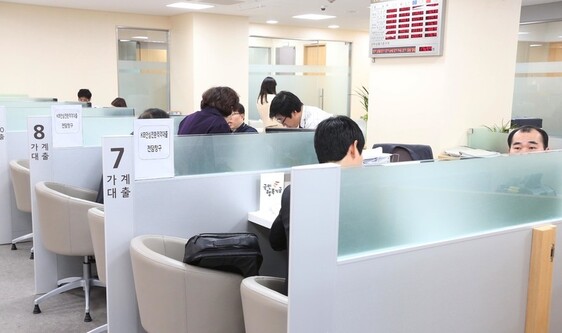
Hankyoreh material photo. Reporter Lee Jung-woo.
It was found that the average bank household credit per capita of first-class creditors with the highest personal credit ratings (grades 1 to 10) was about twice as large as loans from middle-class fourth-class creditors. This is due to the remarkable increase in the size of credit loans for high creditors in recent years, and the difference in loan amount between credit ratings is increasing year by year. Looking at the’Status of handling of banking household credit loans by credit rating (currently credit score)’ submitted by the Democratic Party’s office on the 28th from the personal credit rating company’s NICE rating information, it was ranked first as of the end of December last year. The average household credit balance per creditor was 49.73 million won, an increase of 15.2% (6.6 million won) from the end of the previous year. Compared to the 8.2% (3,280,000 won) in 2019, the increase was even greater. The average credit loan amount per capita for the 2nd grade (37.48 million won→4.161 million won) and the 3rd grade (33.97 million won→3856 million won) also increased by 11.0% (4.13 million won) and 13.4% (4.48 million won) last year, respectively, with an increase of 3.4% and 1.1 in 2019. Compared to %, it showed a sharp increase. On the other hand, only 3.3% (82,000 won) and 0.9% (180,000 won) for the 4th grade (24.46 million won → 250,000 won) and the 5th grade (2129 million won → 2147 million won), respectively. Compared to the declining loan balance in 2019, it is better, but compared to the high-ranking credit rating, the increase in loan amount is minimal. As of last month, the average credit loan amount per person in grade 1 was twice that of grade 4. The difference is larger than 1.8 times in 2019 and 1.6 times in 2018. On the other hand, the difference between credit ratings was relatively small for mortgage loans that borrow money as collateral. The average mortgage balance for first-class creditors was 130.12 million won as of last year, which is almost the same as the average of 12.88 million won for fourth-tier creditors.

The reason why the difference in the balance of credit between high creditors and middle creditors has recently increased seems to be that the demand for credit loans by high creditors is increasing and banks are actively lending them to them. Since the regulation on mortgage loans began in earnest in 2018, the number of people raising some of the funds to purchase houses with household credit loans increased.Last year, the interest rate on credit loans was unusually lower than the interest rate at the head office. It was great. Banks also lowered the risk of insolvency by increasing their loan assets centered on high creditors as profitability deteriorated due to interest rate cuts. Last year, the top five banks also loaned out more than twice their annual income to office workers through credit loans. Compared to this, accessibility to banks of low-credit people among the 4-6 grades did not improve last year. If they need a supply that exceeds the loan limit, they have no choice but to tap the 2nd financial sector. Currently, the interest rate for bank credit loans in grades 4-6 is around 3-7% per year, but the average interest rate for credit loans in the 2nd financial sector jumps to 12-18%. Excluding policy financial products, there are not many customers with mid-interest rate loans between 8 and 11%. Professor Nam Joo-ha of Sogang University (economics) said, “Banks can make money only with high-credit business, and 2 financial sectors are passive with medium-interest-rate loans because they have high interest rates and are profitable.” He pointed out that there should be more personal credit rating models to be evaluated, and a separate financial institution dedicated to heavy interest rate loans such as post office finance should be raised.” By Shin Da-eun, staff reporter [email protected]
